The global urea strippers market is projected to reach USD 10.6 billion by 2035, recording an absolute increase of USD 2.2 billion over the forecast period. The market is valued at USD 8.4 billion in 2025 and is set to rise at a CAGR of 2.4% during the assessment period. The overall market size is expected to grow by nearly 1.3 times during the same period, supported by increasing demand for nitrogen-based fertilizers worldwide, driving demand for efficient urea production systems and increasing investments in agricultural modernization and fertilizer manufacturing projects globally. However, regulatory compliance challenges and complex environmental standards may pose challenges to market expansion.
Between 2025 and 2030, the urea strippers market is projected to expand from USD 8.4 billion to USD 9.4 billion, resulting in a value increase of USD 1.0 billion, which represents 45.5% of the total forecast growth for the decade. This phase of development will be shaped by rising demand for agricultural fertilizers and industrial applications, product innovation in materials technology and high-capacity production systems, as well as expanding integration with environmental compliance and sustainability initiatives. Companies are establishing competitive positions through investment in advanced material formulations, corrosion-resistant production solutions, and strategic market expansion across agriculture, chemical processing, and industrial manufacturing applications.
From 2030 to 2035, the market is forecast to grow from USD 9.4 billion to USD 10.6 billion, adding another USD 1.2 billion, which constitutes 54.5% of the overall ten-year expansion. This period is expected to be characterized by the expansion of specialized stripper systems, including advanced high-capacity formulations and integrated application solutions tailored for specific industry requirements, strategic collaborations between equipment manufacturers and end-user industries, and an enhanced focus on production efficiency and environmental sustainability. The growing emphasis on agricultural productivity optimization and sustainable manufacturing processes will drive demand for advanced, high-performance urea stripper solutions across diverse industrial applications.
The growing global demand for urea, driven by the increasing need for fertilizers in agriculture, is a major factor propelling the market for urea strippers. As the global population rises and agricultural productivity must meet growing food demands, the use of urea-based fertilizers continues to increase. Urea is one of the most widely used nitrogenous fertilizers, making the efficient production and quality control of urea a priority for manufacturers. Urea strippers are essential in ensuring that the ammonia content in the urea solution is minimized, optimizing the final product and preventing any detrimental environmental impacts associated with excess ammonia. This makes urea strippers a critical technology in the urea fertilizer manufacturing process.
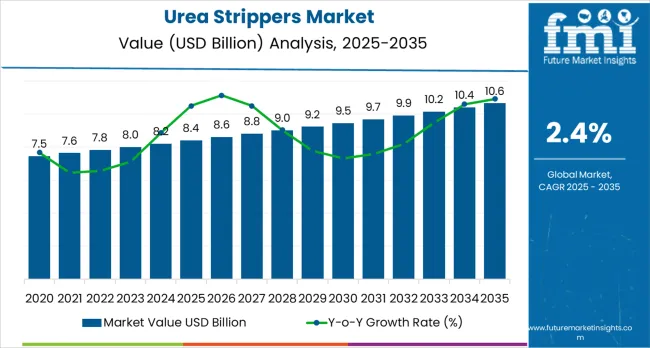
| Metric | Value |
|---|---|
| Market Value (2025) | USD 8.4 billion |
| Market Forecast Value (2035) | USD 10.6 billion |
| Forecast CAGR (2025-2035) | 2.4% |
The urea strippers market grows by enabling manufacturers to achieve superior process efficiency and waste reduction in urea production facilities, ranging from small-scale regional plants to mega fertilizer complexes. Industrial manufacturers face mounting pressure to improve operational efficiency and environmental compliance, with urea stripper solutions typically providing 30-40% improvement in recycling efficiency of unconverted ammonium carbamate compared to conventional systems, making advanced strippers essential for competitive manufacturing operations. The agricultural industry's need for maximum fertilizer production efficiency creates demand for advanced stripper solutions that can minimize waste, enhance durability, and ensure consistent performance across diverse operational conditions. Government initiatives promoting food security and agricultural self-sufficiency drive adoption in fertilizer manufacturing, chemical processing, and industrial applications, where operational performance has a direct impact on production efficiency and environmental compliance. However, raw material price volatility and the complexity of achieving consistent performance across different operational environments may limit adoption rates among cost-sensitive manufacturers and developing regions with limited technical expertise.
The market is segmented by material of construction, capacity, and region. By material of construction, the market is divided into duplex steel, stainless steel, zirconium, titanium, 25 Cr-22Ni-2Mo, and 316 L-UG. Based on capacity, the market is categorized into upto 1,000 MTPD, 1,000-1,500 MTPD, 1,500-3,500 MTPD, and above 3,500 MTPD. Regionally, the market is divided into North America, Latin America, Western Europe, Eastern Europe, East Asia, South Asia Pacific, and Middle East &Africa.
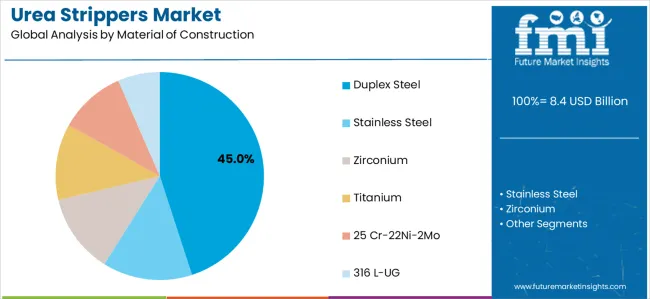
The duplex steel segment represents the dominant force in the urea strippers market, capturing approximately 45.0% of total market share in 2025. This advanced material category encompasses formulations featuring superior corrosion resistance characteristics, including enhanced strength-to-weight ratio and optimized performance combinations that enable superior operational durability and enhanced resistance characteristics. The duplex steel segment's market leadership stems from its exceptional performance capabilities in high-temperature, high-pressure environments, with materials capable of withstanding aggressive ammonia-carbamate conditions while maintaining consistent performance and environmental resistance across diverse operating conditions.
The stainless steel segment maintains a substantial market share, serving manufacturers who require cost-effective corrosion-resistant solutions for standard applications. These materials offer reliable performance for general-purpose urea production applications while providing sufficient durability to meet basic performance requirements in fertilizer manufacturing and chemical processing applications.
Key technological advantages driving the duplex steel segment include:
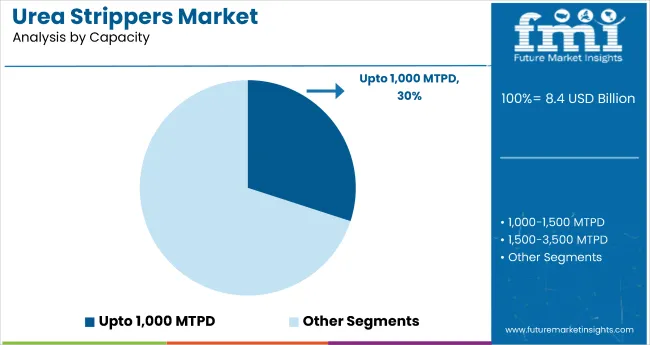
Upto 1,000 MTPD capacity applications dominate the urea strippers market with approximately 30.0% market share in 2025, reflecting the critical role of medium-scale production facilities in serving regional fertilizer demand and supporting decentralized manufacturing initiatives. The medium-capacity segment's market leadership is reinforced by increasing regional fertilizer production, standardized equipment designs, and rising demand for cost-effective production optimization that directly correlates with operational flexibility and market responsiveness.
The 1,500-3,500 MTPD segment represents the second-largest capacity category, capturing significant market share through specialized requirements for large-scale industrial facilities, mega fertilizer plants, and high-volume production operations. This segment benefits from growing demand for high-capacity systems that meet stringent efficiency, durability, and performance requirements in demanding industrial applications.
The 1,000-1,500 MTPD segment accounts for substantial market share, serving medium-scale manufacturers requiring balanced production capacity solutions. The above 3,500 MTPD segment captures market share through mega-scale applications, while other capacity ranges represent specialized market segments.
Key market dynamics supporting capacity growth include:
The market is driven by three concrete demand factors tied to agricultural and industrial optimization outcomes. First, global fertilizer demand growth and agricultural modernization create increasing demand for high-performance urea production solutions, with global population projected to exceed 9 billion by 2050, requiring specialized equipment solutions for maximum production efficiency. Second, modernization of legacy urea facilities and environmental compliance drive the adoption of superior stripper technologies, with manufacturers seeking 30-40% improvement in process efficiency and regulatory compliance enhancement. Third, technological advancements in materials science and corrosion-resistant technologies enable more effective and durable equipment solutions that reduce maintenance requirements while improving long-term performance and cost-effectiveness.
Market restraints include raw material price volatility that can impact production costs and profitability margins, particularly during periods of supply chain disruption or commodity price fluctuations affecting key steel and specialty alloy components. Regulatory complexity in environmental compliance poses another significant challenge, as achieving consistent performance standards across different operational conditions and regulatory frameworks requires specialized expertise and quality control systems, potentially causing project delays and increased manufacturing costs. Technical complexity in system integration and customization requirements create additional challenges for manufacturers, demanding ongoing investment in engineering capabilities and compliance with varying regional environmental standards.
Key trends indicate accelerated adoption in emerging markets, particularly China, India, and Brazil, where rapid agricultural modernization and fertilizer capacity expansion drive comprehensive urea production system development. Technology advancement trends toward AI integration with enhanced predictive maintenance, process optimization, and multi-functional equipment capabilities enable next-generation product development that addresses multiple performance requirements simultaneously. However, the market thesis could face disruption if alternative fertilizer production technologies or significant changes in agricultural practices minimize reliance on traditional urea manufacturing solutions.
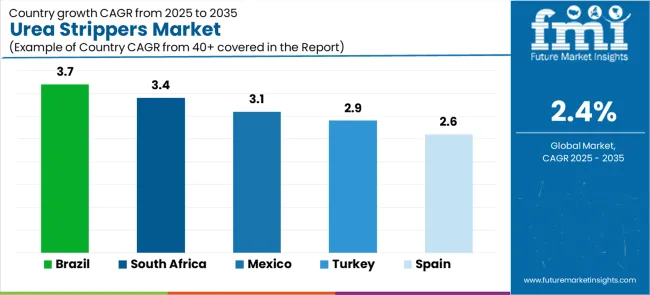
| Country | CAGR (2025-2035) |
|---|---|
| Brazil | 3.7% |
| South Africa | 3.4% |
| Mexico | 3.1% |
| Turkey | 2.9% |
| Spain | 2.6% |
The urea strippers market is gaining momentum worldwide, with Brazil taking the lead thanks to massive agricultural expansion and government-backed fertilizer self-sufficiency programs. Close behind, South Africa benefits from growing agricultural modernization and mining-related fertilizer demand initiatives, positioning itself as a strategic growth hub in the African region. Mexico shows steady advancement, where integration of advanced agricultural technologies strengthens its role in the North American fertilizer and food production supply chains. Turkey is focusing on agricultural development and industrial modernization, signaling an ambition to capitalize on growing opportunities in Middle Eastern agricultural markets. Meanwhile, Spain stands out for its advanced agricultural technology development in existing fertilizer applications, recording consistent progress in agricultural productivity advancement. Together, Brazil and South Africa anchor the global expansion story, while the rest build stability and diversity into the market's growth path.
The report covers an in-depth analysis of 40+ countries top-performing countries are highlighted below.
Brazil demonstrates the strongest growth potential in the Urea Strippers Market with a CAGR of 3.7% through 2035. The country's leadership position stems from massive agricultural expansion projects, government-backed food security programs, and aggressive fertilizer self-sufficiency targets, driving the adoption of high-performance urea production systems. Growth is concentrated in major agricultural regions, including São Paulo, Minas Gerais, Rio Grande do Sul, and Mato Grosso, where fertilizer manufacturers and agricultural companies are implementing advanced stripper solutions for enhanced production performance and international competitiveness. Distribution channels through established equipment suppliers and direct manufacturer relationships expand deployment across fertilizer manufacturing facilities and agricultural processing centers. The country's agricultural leadership strategy provides policy support for advanced manufacturing development, including high-performance equipment system adoption.
Key market factors:
In Johannesburg, Cape Town, Durban, and Pretoria, the adoption of urea stripper systems is accelerating across fertilizer manufacturing facilities and agricultural processing centers, driven by food security targets and government agricultural modernization initiatives. The market demonstrates strong growth momentum with a CAGR of 3.4% through 2035, linked to comprehensive agricultural capacity expansion and increasing focus on manufacturing competitiveness solutions. South African manufacturers are implementing advanced stripper systems and quality control platforms to enhance production performance while meeting growing demand for fertilizers in domestic and export markets. The country's agricultural development programs create sustained demand for high-performance production solutions, while increasing emphasis on local manufacturing drives adoption of advanced materials and production technologies.
Mexico's advanced agricultural industry demonstrates sophisticated implementation of urea stripper systems, with documented case studies showing efficiency improvements in fertilizer applications through optimized production solutions. The country's manufacturing infrastructure in major agricultural centers, including Jalisco, Sinaloa, Veracruz, and Michoacán, showcases integration of advanced equipment technologies with existing production systems, leveraging expertise in agricultural processing and precision manufacturing. Mexican manufacturers emphasize quality standards and environmental compliance, creating demand for high-performance equipment solutions that support sustainability initiatives and regulatory requirements. The market maintains steady growth through focus on agricultural innovation and production competitiveness, with a CAGR of 3.1% through 2035.
Key development areas:
Turkey's market expansion is driven by diverse agricultural demand, including fertilizer production in Ankara and Istanbul regions, manufacturing development in Izmir and Bursa, and comprehensive industrial modernization across multiple agricultural areas. The country demonstrates promising growth potential with a CAGR of 2.9% through 2035, supported by national agricultural programs and regional industrial development initiatives. Turkish manufacturers face implementation challenges related to technology transfer and technical expertise availability, requiring equipment upgrade approaches and international partnership support. However, growing agricultural targets and manufacturing competitiveness requirements create compelling business cases for urea stripper system adoption, particularly in fertilizer manufacturing regions where performance optimization has a direct impact on agricultural competitiveness.
Market characteristics:
Spain's market leads in advanced agricultural innovation based on integration with next-generation fertilizer technologies and sophisticated processing applications for enhanced performance characteristics. The country shows solid potential with a CAGR of 2.6% through 2035, driven by agricultural modernization programs and advanced manufacturing initiatives across major agricultural regions, including Andalusia, Catalonia, Valencia, and Castile-La Mancha. Spanish manufacturers are adopting advanced stripper systems for production optimization and regulatory compliance, particularly in regions with agricultural mandates and advanced processing facilities requiring superior product differentiation. Technology deployment channels through established equipment distributors and direct manufacturer relationships expand coverage across fertilizer manufacturing and agricultural processing facilities.
Leading market segments:
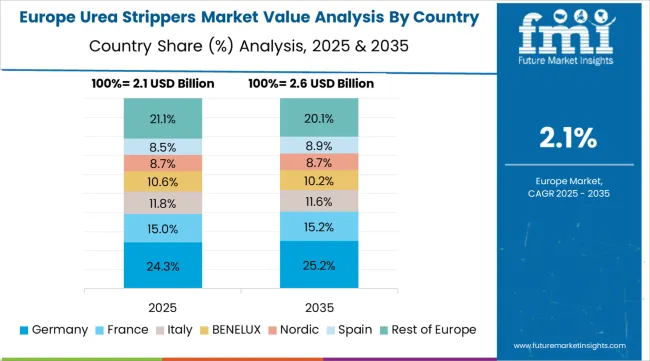
The urea strippers market in Europe is projected to grow from USD 1.8 billion in 2025 to USD 2.4 billion by 2035, registering a CAGR of 2.9% over the forecast period. Germany is expected to maintain its leadership position with a 28.5% market share in 2025, declining slightly to 28.1% by 2035, supported by its extensive chemical manufacturing infrastructure and major industrial centers, including Bavaria, North Rhine-Westphalia, and Baden-Württemberg production facilities.
Spain follows with a 22.4% share in 2025, projected to reach 22.8% by 2035, driven by comprehensive agricultural development programs and advanced manufacturing initiatives implementing stripper technologies. France holds a 18.7% share in 2025, expected to maintain 18.3% by 2035 through ongoing industrial facility upgrades and chemical technology development. Italy commands a 15.2% share, while the United Kingdom accounts for 9.8% in 2025. The Rest of Europe region is anticipated to gain momentum, expanding its collective share from 5.4% to 6.5% by 2035, attributed to increasing urea stripper adoption in Nordic countries and emerging Eastern European manufacturing facilities implementing advanced equipment programs.
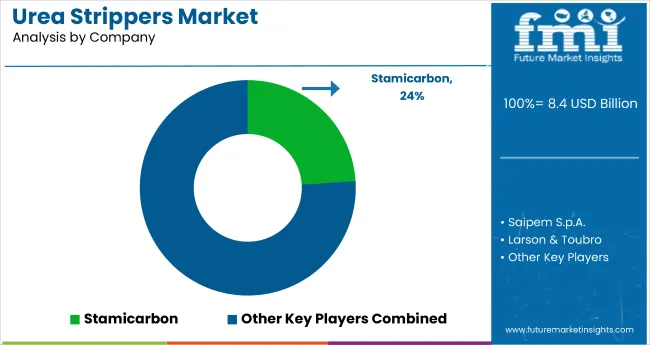
The urea strippers market is composed of 12–16 key players, with the top five companies controlling 55–60% of the global market share, driven by their advanced engineering capabilities, long-standing relationships with the fertilizer industry, and expertise in urea production technologies. Competition centers on system efficiency, cost-effectiveness, scalability, and compliance with environmental standards, rather than price alone. Larsen & Toubro leads the market with an 12% share, bolstered by its vast experience in large-scale industrial projects, its engineering expertise, and its strong presence in the global urea production sector.
Market leaders such as Larsen & Toubro, Saipem S.p.A., Stamicarbon, and Urea Casale maintain dominance through their high-efficiency urea stripper designs, advanced process optimization techniques, and integration with large urea production facilities. These companies benefit from their ability to provide customized, reliable solutions that meet stringent environmental regulations and operational efficiency requirements, making them preferred partners for large chemical and fertilizer plants worldwide.
Challengers including TOYO India, Alfa Laval, Thyssenkrupp, and FLOWTRONIX focus on offering specialized solutions for specific regional needs or application segments, differentiating through tailored designs, cost-effective alternatives, and enhanced technical support services. Regional players such as Images Heavy Engineering Ltd, Kay Iron Works (Jorian) Private Limited, and FEECO International, Inc. strengthen their positions by leveraging localized manufacturing capabilities, competitive pricing, and expertise in smaller-scale operations. Emerging players like Sandvik AB, MANGIAROTTI spa, and Paramount Limited add innovation to the market by introducing advanced materials and custom solutions for unique urea stripping challenges.
Urea strippers represent specialized industrial equipment that enable manufacturers to achieve 30-40% improvement in process efficiency compared to conventional systems, delivering superior operational performance and waste reduction with enhanced recycling capabilities in demanding fertilizer production applications. With the market projected to grow from USD 8.4 billion in 2025 to USD 10.6 billion by 2035 at a 2.4% CAGR, these equipment systems offer compelling advantages - enhanced production efficiency, customizable capacity configurations, and operational durability - making them essential for fertilizer manufacturing applications, chemical processing operations, and industrial facilities seeking alternatives to inefficient production systems that compromise performance through excessive waste generation. Scaling market adoption and technological advancement requires coordinated action across agricultural policy, industrial standards development, equipment manufacturers, processing industries, and materials science investment capital.
How Governments Could Spur Local Production and Adoption?
How Industry Bodies Could Support Market Development?
How OEMs and Technology Players Could Strengthen the Ecosystem?
How Suppliers Could Navigate the Shift?
How Investors and Financial Enablers Could Unlock Value?
| Item | Value |
|---|---|
| Quantitative Units | USD 8.4 billion |
| Material of Construction | Duplex Steel, Stainless Steel, Zirconium, Titanium, 25 Cr-22Ni-2Mo, 316 L-UG |
| Capacity | Upto 1,000 MTPD, 1,000-1,500 MTPD, 1,500-3,500 MTPD, Above 3,500 MTPD |
| Regions Covered | North America, Latin America, Western Europe, Eastern Europe, East Asia, South Asia Pacific, Middle East &Africa |
| Country Covered | Brazil, South Africa, Mexico, Turkey, Spain, and 40+ countries |
| Key Companies Profiled | Larsen & Toubro, Saipem S.p.A., Stamicarbon, Urea Casale, TOYO India, Alfa Laval, Thyssenkrupp, FLOWTRONIX, Images Heavy Engineering Ltd, Kay Iron Works (Jorian) Private Limited, FEECO International, Inc., Sandvik AB, MANGIAROTTI spa, and Paramount Limited |
| Additional Attributes | Dollar sales by material of construction and capacity categories, regional adoption trends across Latin America, Middle East &Africa, and South Asia Pacific, competitive landscape with equipment providers and technology integrators, manufacturing facility requirements and specifications, integration with agricultural initiatives and fertilizer systems, innovations in equipment technology and manufacturing systems, and development of specialized configurations with performance and durability capabilities. |
The global urea strippers market is estimated to be valued at USD 8.4 billion in 2025.
The market size for the urea strippers market is projected to reach USD 10.6 billion by 2035.
The urea strippers market is expected to grow at a 2.4% CAGR between 2025 and 2035.
The key product types in urea strippers market are duplex steel, stainless steel, zirconium, titanium, 25 cr-22ni-2mo and 316 l-ug.
In terms of capacity, upto 1,000 mtpd segment to command 30.0% share in the urea strippers market in 2025.






Our Research Products

The "Full Research Suite" delivers actionable market intel, deep dives on markets or technologies, so clients act faster, cut risk, and unlock growth.

The Leaderboard benchmarks and ranks top vendors, classifying them as Established Leaders, Leading Challengers, or Disruptors & Challengers.

Locates where complements amplify value and substitutes erode it, forecasting net impact by horizon

We deliver granular, decision-grade intel: market sizing, 5-year forecasts, pricing, adoption, usage, revenue, and operational KPIs—plus competitor tracking, regulation, and value chains—across 60 countries broadly.

Spot the shifts before they hit your P&L. We track inflection points, adoption curves, pricing moves, and ecosystem plays to show where demand is heading, why it is changing, and what to do next across high-growth markets and disruptive tech

Real-time reads of user behavior. We track shifting priorities, perceptions of today’s and next-gen services, and provider experience, then pace how fast tech moves from trial to adoption, blending buyer, consumer, and channel inputs with social signals (#WhySwitch, #UX).

Partner with our analyst team to build a custom report designed around your business priorities. From analysing market trends to assessing competitors or crafting bespoke datasets, we tailor insights to your needs.
Supplier Intelligence
Discovery & Profiling
Capacity & Footprint
Performance & Risk
Compliance & Governance
Commercial Readiness
Who Supplies Whom
Scorecards & Shortlists
Playbooks & Docs
Category Intelligence
Definition & Scope
Demand & Use Cases
Cost Drivers
Market Structure
Supply Chain Map
Trade & Policy
Operating Norms
Deliverables
Buyer Intelligence
Account Basics
Spend & Scope
Procurement Model
Vendor Requirements
Terms & Policies
Entry Strategy
Pain Points & Triggers
Outputs
Pricing Analysis
Benchmarks
Trends
Should-Cost
Indexation
Landed Cost
Commercial Terms
Deliverables
Brand Analysis
Positioning & Value Prop
Share & Presence
Customer Evidence
Go-to-Market
Digital & Reputation
Compliance & Trust
KPIs & Gaps
Outputs
Full Research Suite comprises of:
Market outlook & trends analysis
Interviews & case studies
Strategic recommendations
Vendor profiles & capabilities analysis
5-year forecasts
8 regions and 60+ country-level data splits
Market segment data splits
12 months of continuous data updates
DELIVERED AS:
PDF EXCEL ONLINE
Urea Formaldehyde Market Size and Share Forecast Outlook 2025 to 2035
Thiourea Market Size and Share Forecast Outlook 2025 to 2035
Polyurea Coatings Market Growth - Trends & Forecast 2025 to 2035
Polyurea Greases Market
Blood Urea Nitrogen Diagnostics Market
Blood Urea Nitrogen Testing Market
Service Bureau Market Analysis - Size, Growth, and Forecast 2025 to 2035
Pneumatic Strippers Market
Paper Waste Strippers Market Size and Share Forecast Outlook 2025 to 2035
Assessing Paper Waste Strippers Market Share & Industry Trends
Sulphur Coated Urea Market Growth - Trends & Forecast 2025 to 2035
Nitrification and Urease Inhibitors Market Size and Share Forecast Outlook 2025 to 2035
Commercial Vehicle Urea Tank Market Size and Share Forecast Outlook 2025 to 2035
Currency Exchange Bureau Software Market – FinTech Evolution

Thank you!
You will receive an email from our Business Development Manager. Please be sure to check your SPAM/JUNK folder too.
Chat With
MaRIA